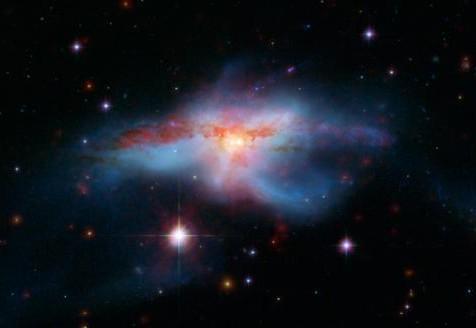The new image by the Spitzer Space Telescope (NASA) shows that impending collisions occur between the central part of the two galaxies. They are powered by a black hole that is millions of times more massive than the sun.
The two central regions of the galaxy are in a messy galaxy called NGC 6240, located 400 million light-years away in the constellation Ophiuchus. Millions of years ago, each core was a dense center before the two galaxies collided and impacted each other. Currently these two cores are approaching each other at breakneck speed, preparing for the last major collision. They will crash into each other within just a few million years, a period of time that seems to be large but is essentially just lightning to the time of the galaxies.
This stunning picture combines visible light from the Hubble Space Telescope (NASA) and the infrared light of the Spitzer Telescope. The picture captured two galaxies in a short and rare development phase when both cores of two interacting galaxies could still be observed as they approached each other quickly.
Stephanie Bush is part of the Harvard-Smithsonian Center for Astrophysics, Cambridge, Mass. The main author of this observational paper in the Astrophysical Journal said: 'One of the most interesting things about the image is the uniqueness of the object. Combining together is a quick process, like a train accident going on. In the universe there are not many galactic mergers at this stage. '
NGC 6240 releases a large amount of infrared light, which is a sign that an explosion of star formation is taking place. Extremely powerful infrared radiation is common in interacting galaxies, when two galaxies interact with each other, the gas and dust are coiled together to form new stars that produce infrared light. Such galaxies are called infrared glowing galaxies. The Spitzer telescope's infrared camera can capture the image of tremendous heat from newly formed stars, although their visible light is obscured by dense dust clouds around.
 The image of two galaxies called NGC 6240 collides with each other in a short and rare phase in the development process before they enter together to form a larger galaxy. (Photo: NASA / JPL-Caltech / STScI-ESA)
The image of two galaxies called NGC 6240 collides with each other in a short and rare phase in the development process before they enter together to form a larger galaxy. (Photo: NASA / JPL-Caltech / STScI-ESA)
The galaxy's drop-like shape is due to the tremendous strength that is sustained by the collision. Flows include millions of stars torn out of the galaxy, forming arms stretching from NGC 6240 in different directions.Events seem to become even more powerful when the main merger event occurs and when the two galaxy centers merge into one.
At the heart of NGC 6240, two black holes will emit crazy radiation as they get closer and closer, like turning a galaxy into a monster - a bright, bright infrared galaxy nearly thousands of times. Milky Way galaxy. Another interesting aspect of this object is that there are no two mergers between two similar galaxies. "These objects are very rare, and every galaxy is unique because they come from different ancestral galaxies," Bush said . This observation gives us a new layer of information about the galaxy, as well as the general intergalactic integration '.
Infrared light due to Spitzer infrared cameras at 3.6 and 8.8 microns (red) shows cold dust clouds and radiation emitted from star formation, visible light that Hubble telescope captures (blue Green leaves and green leaves show hot air and stars.
Other authors of the paper include Zhong Wang, Margarita Karovska and Giovanni Fazio, all of which belong to the Harvard-Smithsonian Center for Astrophysics. The NASA Jet Laboratory, Pasadena, Calif., Controls the Spitzer Space Telescope to implement this program. Scientific observations were made at the Spizer Science Center at the California Institute of Technology, at the same time in Pasadena.
 Van Allen's belt and evidence that the Apollo 11 mission to the Moon was myth
Van Allen's belt and evidence that the Apollo 11 mission to the Moon was myth The levels of civilization in the universe (Kardashev scale)
The levels of civilization in the universe (Kardashev scale) Today Mars, the sun and the Earth are aligned
Today Mars, the sun and the Earth are aligned The Amazon owner announced a secret plan to build a space base for thousands of people
The Amazon owner announced a secret plan to build a space base for thousands of people